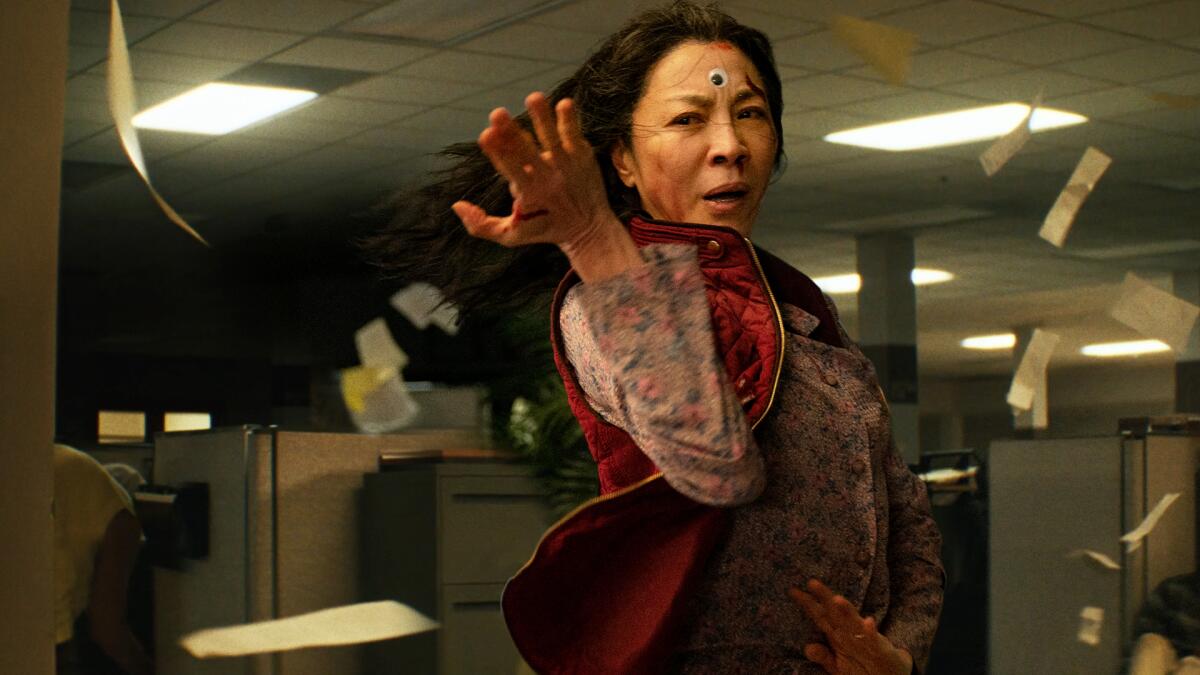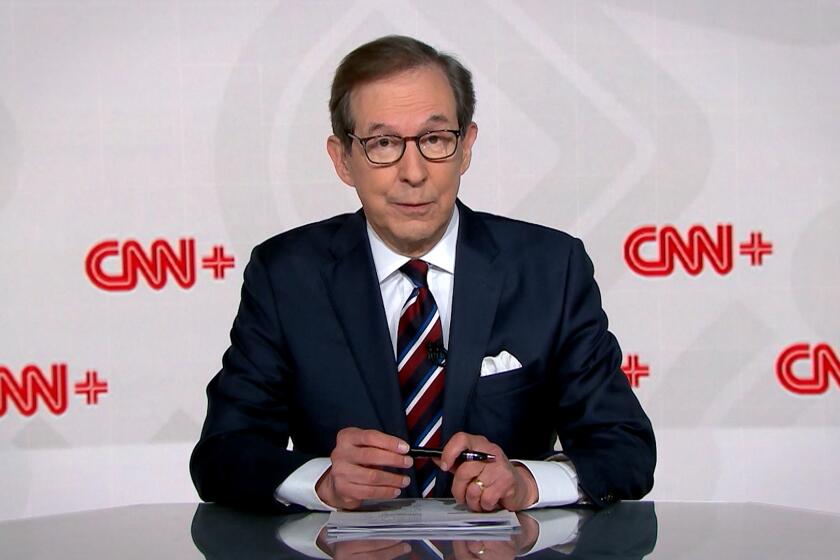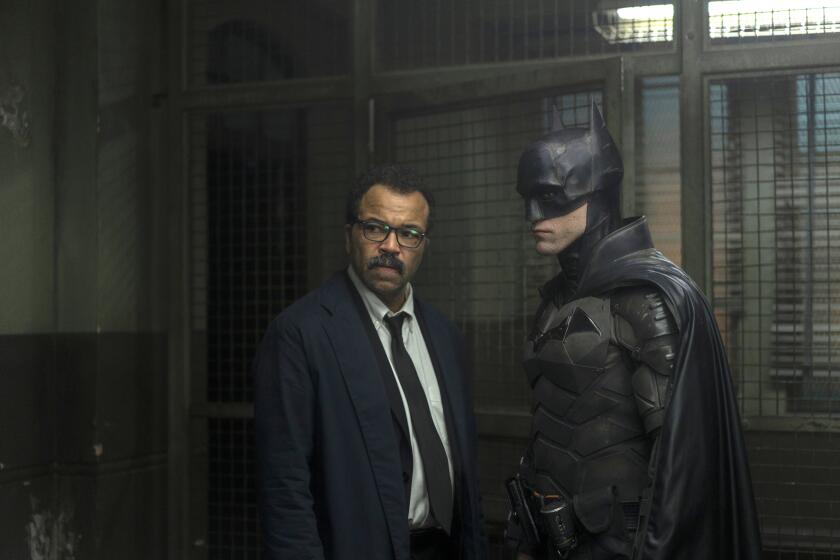After streaming’s worst week, Hollywood bows at the altar of cinema

- Share via
The ascendant business of streaming video, which has for years been seen as the biggest threat to the traditional entertainment industry, just had quite possibly its worst week ever. Netflix’s stock got crushed. CNN+ got killed.
What a time for Hollywood to bow at the altar of movie theaters, right?
This week, the major film studios — Disney, Warner Bros., Universal, Paramount and Sony — along with smaller distributors have gathered in Las Vegas to kiss the ring of the world’s movie theater operators, from the biggest multinational chains to the smallest mom-and-pops.
At this year’s CinemaCon at Caesars Palace, celebrities, directors and studio chiefs will once again take the stage to tout upcoming summer movies, unveil new trailers and behind-the-scenes footage and, above all, talk up the majesty of the cinema experience.
Even during the direst of times, the Colosseum during CinemaCon is a pulpit from which studio bosses and exhibitors proclaim, often defiantly, that they’re not going anywhere and that nothing can replace the collective joy of watching a big screen in a dark theater.
New CNN President Chris Licht said in a memo that the service will cease operation April 30.
This year, the stakes are as high as they’ve ever been. Cinema operators desperately tried to keep the big screen alive during the COVID-19 pandemic, which shuttered movie theaters for months. In Los Angeles, America’s filmgoing capital, movie houses were closed for a year, and some of the most popular — the old site of ArcLight Hollywood, for example — remain lifeless.
Meanwhile, streaming services multiplied and grew at an astounding pace as media companies tried to take down Netflix, the dominant player in home viewing subscriptions. To adapt to pandemic closures, studios sent films directly to streaming. And to add insult to injury, this year’s Oscar for best picture went to “CODA,” released by Apple TV+ and only nominally in theaters.
The future wasn’t about buying tickets and popcorn. It was about an all-you-can-eat buffet of shows and movies seen from your couch. As such, last year’s CinemaCon, held in August, was a muted affair, marked by theater executives practically pleading with studios to show movies in theaters before making them available online.
The pandemic permanently changed the way studios bring movies to audiences. Not as many films will go to theaters, and those that do will start streaming much earlier than they once would have.
‘CODA’ was the big 2022 Oscars winner for Apple, which faced heavy skepticism in 2019 when it launched Apple TV+. Now can it compete for subscribers?
So what is there to gloat about?
For one thing, it’s becoming increasingly clear that the most dire predictions about the doom facing theaters were exaggerated.
Studios now are, in fact, releasing movies in theaters first, and seeing the benefits at the box office. Sony’s “Spider-Man: No Way Home” grossed $1.89 billion in global box office revenue, while Warner Bros.’ “The Batman” took in an impressive $752.6 million in worldwide receipts. It’s not just superheroes, either. Paramount’s “Sonic the Hedgehog 2,” “The Lost City” and “Jackass Forever” did solid business. So did Sony’s “Uncharted,” starring “Spider-Man’s” Tom Holland.
The results are giving studios and analysts hope that a summer movie slate with a number of potential blockbusters will get more butts back in seats.
“I’m pleasantly surprised,” said producer Jason Blum, known for movies including “Get Out,” “BlacKkKlansman” and the “Purge” series. “I think that theatrical pre- and post-COVID are different animals, but clearly there’s a big segment of the population that’s anxious to get out of their house and go to a movie. And I’m happy about that. We won’t have as much choice as we did before. But at least every movie theater is not closing down as some people predicted.”
Data may debunk the notion that people are feeling “oversubscribed” to video streaming services.
Disney’s “Doctor Strange in the Multiverse of Madness” should continue Marvel’s superhero winning streak with the return of Benedict Cumberbatch and other stalwarts of the series. “Top Gun: Maverick,” the long-awaited sequel starring Tom Cruise, could bring back older audiences who have been hesitant to return amid the persistent pandemic. Pixar’s “Lightyear” and Universal and Illumination Entertainment’s “Minions: The Rise of Gru” should attract families in a big way.
There’s also anticipation for movies set for beyond the summer. Will Disney use CinemaCon to finally unveil a trailer for James Cameron’s long-delayed “Avatar 2,” set for release in December? That would get people’s attention.
Box office in the U.S. and Canada is expected to total more than $9 billion this year, about 20% less than the $11.4 billion reached in 2019, according to B. Riley Securities analyst Eric Wold, who covers the exhibition industry. But it’s more than double last year’s paltry $4.4 billion. Wold expects revenue to come within 3% of 2019 levels next year.
Some of the growth is because movie tickets, like pretty much everything else right now, are getting more expensive. Returning moviegoers are increasingly gravitating toward “premium” formats, such as Imax, to maximize the difference between going to the movies and sitting at home. Major chains including AMC, Cinemark and Regal have begun to charge slightly more for the opening-weekend showtimes of the most popular films. The average ticket price is expected to grow 5% this year compared with 2019.
AMC on Tuesday introduced the idea of variable ticket pricing for movies, an established practice in Europe.
But the main factor driving the recovery is that the movies themselves are back. In a sign of confidence, studios have mostly stopped delaying their big releases, unlike last year when the release schedule seemed to change from month to month, depending on COVID-19 variant-driven surges.
“At this point, you’ve got a pretty solid outlook,” Wold said. “You got a slate that’s holding in. There hasn’t been a lot of movement in months.”
Still, the movie business is markedly different from what it was three years ago. Most studios are releasing films exclusively in theaters for about 45 days before making them available for home viewing, either through their own streaming outlets or for sale on platforms like iTunes and Amazon. That’s a much shorter wait than the average 90-day gap, known as the theatrical window, that was standard before the pandemic.
Many distributors have long wanted a more flexible window. A one-size-fits-all approach to releasing movies never made sense, even before COVID-19 turned the business upside down, said Tom Quinn, the founder and CEO of Neon, which released the 2020 best picture winner, “Parasite.” Fueled by word-of-mouth, that South Korean thriller grossed $53 million in the U.S. and Canada, a stunning result for a non-English-language film.
“Ninety days didn’t work for me on ‘Parasite’; 150 days did,” Quinn said. “The bad news is, it took a pandemic for everybody to come together and say, ‘Is there a better way to do this?’ That conversation could have been had 15 years ago, but the powers that be were unwilling to test the waters.”
The major studios are expected to make fewer movies exclusively for theaters. Warner Bros. sent its entire 2021 lineup to its sibling streaming service, HBO Max, and theaters simultaneously, a tactic that grew subscriber numbers but slashed box office sales.
The studio is employing a 45-day window for theatrical movies this year (“The Batman” recently hit the platform for no additional charge) while also sending many movies direct to streaming, as it did with Steven Soderbergh’s thriller “Kimi” in February. Disney’s Bob Chapek has signaled flexibility when it comes to premiering movies in theaters or putting them on Disney+, the streaming service that is the Burbank giant’s top priority.
The business is consolidating into one driven by a few blockbusters and genres. Comic book-based action movies work and dominate sales. Horror movies — like “Scream” — tend to do well because they benefit from communal viewing. Family movies also do strong sales. But romantic comedies, comedies and adult-oriented thrillers? Those movies are increasingly becoming fodder for streaming.
But then there’s a subset of wild cards, said Blum, whose horror film “The Black Phone” from Universal will play in its entirety at CinemaCon. Blum describes a “fourth category” of movie, one that isn’t a superhero, horror or animated film but that a studio can still market as a must-see event, driven by a special filmmaker who can get audiences excited.
A24’s “Everything Everywhere All at Once,” an independent science fiction film starring Michelle Yeoh, has been picking up momentum because of its daring concept involving the multiverse and its quirky humor. The film has grossed more than $27 million domestically so far. Next year, there’s Christopher Nolan’s “Oppenheimer,” a historical drama starring Cillian Murphy, about the father of the atomic bomb. There’s precedent for such a film working: Nolan’s 2017 World War II hit “Dunkirk.”
“The question is, ‘Does “Dunkirk” work post-pandemic?’” Blum said. “I would posit that yes, it does.”
What doesn’t work is what some in the business call “get-around-to” movies, or films that cost $20 million to $50 million and don’t demand that audiences see them right away to be part of the cultural conversation. Such films used to fill up the schedule and allow everyone involved to make a little bit of money. These were known as solid “singles and doubles,” in the lingo of Hollywood. But those films, politely known as “programmers,” are mostly relics of the past.
“That movie is on your TV set now,” Blum said. “It’s not at your movie theater.”
CinemaCon comes amid signs that investors are starting to sour a bit on the streaming business, which has been positioned as both the grim reaper and the savior of movies, depending on who’s talking.
Netflix, long Wall Street’s golden child, lost subscribers for the first time in more than a decade during its most recent quarter, reporting a loss of about 200,000 accounts worldwide. The company blamed rampant password sharing and a pandemic that clouded its vision of how quickly it could grow. Its stock plummeted 35%, its worst day since 2004, on worries that the subscriber business is becoming saturated.
CNN+, the new streamer launched by the cable news giant, was smothered in its crib less than one month following its launch, after its parent company was taken over by Discovery. Programming from CNN is expected to become part of a larger HBO Max streaming offering, along with Discovery shows.
Despite some cause for optimism among the theater operators, they’re still a long way from full strength. AMC Entertainment, the world’s largest theater chain, reported a loss of $134.4 million in its most recent quarter, though that was better than the $946 million loss the Leawood, Kan.-based company posted during the same quarter a year earlier.
AMC’s stock has gone on a wild ride during the last couple of years, soaring from as low as $2 a share to more than $60 in June, amid the WallStreetBets-fueled rush to pile into GameStop and other “meme stock” companies. The phenomenon helped save AMC from bankruptcy, but shares have since come back to earth, declining 55% in the past six months to $16.96.
To Quinn, the most important lesson of the pandemic is that theatrical releases make films more valuable. Would film buffs be talking so effusively about “Everything Everywhere All at Once” if it were released only on streaming? Why else, Quinn asked, would streamers be falling over themselves to premiere their most prestigious movies at film festivals like Sundance?
“It’s less valuable at home than it is in the theater,” he said. “It happens to be more valuable at home when and if it’s been successfully released theatrically. That still holds true.”
More to Read
Inside the business of entertainment
The Wide Shot brings you news, analysis and insights on everything from streaming wars to production — and what it all means for the future.
You may occasionally receive promotional content from the Los Angeles Times.















